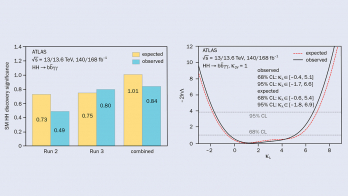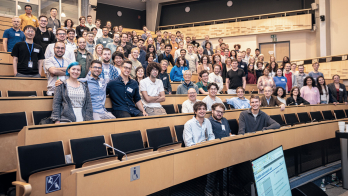A report from the ATLAS experiment.

Supersymmetry (SUSY) provides elegant solutions to many of the problems of the Standard Model (SM) by introducing new boson/fermion partners for each SM fermion/boson, and by extending the Higgs sector. If SUSY is realised in nature at the TeV scale, it would accommodate a light Higgs boson without excessive fine-tuning. It could furthermore provide a viable dark-matter candidate, and be a key ingredient to the unification of the electroweak and strong forces at high energy. The SUSY partners of the SM bosons can mix to form what are called charginos and neutralinos, collectively referred to as electroweakinos.
Electroweakinos would be produced only through the electroweak interaction, where their production cross sections in proton–proton collisions are orders of magnitude smaller than strongly produced squarks and gluinos (the supersymmetric partners of quarks and gluons). Therefore, while extensive searches using the Run 1 (7–8 TeV) and Run 2 (13 TeV) LHC datasets have turned up null results, the corresponding chargino/neutralino exclusion limits remain substantially weaker than those for strongly interacting SUSY particles.
The ATLAS collaboration has recently released a comprehensive analysis of the electroweak SUSY landscape based on its Run 2 searches. Each individual search targeted specific chargino/neutralino production mechanisms and subsequent decay modes. The analyses were originally interpreted in so-called “simplified models”, where only one production mechanism is considered, and only one possible decay. However, if SUSY is realised in nature, its particles will have many possible production and decay modes, with rates depending on the SUSY parameters. The new ATLAS analysis brings these pieces together by reinterpreting 10 searches in the phenomenological Minimal Supersymmetric Standard Model (pMSSM), which includes a range of SUSY particles, production mechanisms and decay modes governed by 19 SUSY parameters. The results provide a global picture of ATLAS’s sensitivity to electroweak SUSY and, importantly, reveals the gaps that remain to be explored.

The 19-dimensional pMSSM parameter space was randomly sampled to produce a set of 20,000 SUSY model points. The 10 selected ATLAS searches were then performed on each model point to determine whether it is excluded with at least 95% confidence level. This involved simulating datasets for each SUSY model, and re-running the corresponding analyses and statistical fits. An extensive suite of reinterpretation tools was employed to achieve this, including preserved likelihoods and RECAST – a framework for preserving analysis workflows and re-applying them to new signal models.
The results show that, while electroweakino masses have been excluded up to 1 TeV in simplified models, the coverage with regard to the pMSSM is not exhaustive. Numerous scenarios remain viable, including mass regions nominally covered by previous searches (inside the dashed line in figure 1). The pMSSM models may evade detection due to smaller production cross-sections and decay probabilities compared to simplified models. Scenarios with small mass-splittings between the lightest and next-to-lightest neutralino can reproduce the dark-matter relic density, but are particularly elusive at the LHC. The decays in these models produce challenging event features with low-momentum particles that are difficult to reconstruct and separate from SM events.
Beyond ATLAS, experiments such as LZ aim at detecting relic dark-matter particles through their scattering by target nuclei. This provides a complementary probe to ATLAS searches for dark matter produced in the LHC collisions. Figure 2 shows the LZ sensitivity to the pMSSM models considered by ATLAS, compared to the sensitivity of its SUSY searches. ATLAS is particularly sensitive to the region where the dark-matter candidate is around half the Z/Higgs-boson mass, causing enhanced dark-matter annihilation that could have reduced the otherwise overabundant dark-matter relic density to the observed value.
The new ATLAS results demonstrate the breadth and depth of its search programme for supersymmetry, while uncovering its gaps. Supersymmetry may still be hiding in the data, and several scenarios have been identified that will be targeted, benefiting from the incoming Run 3 data.
Further reading
ATLAS Collab. 2024 arXiv:2402.01392.








